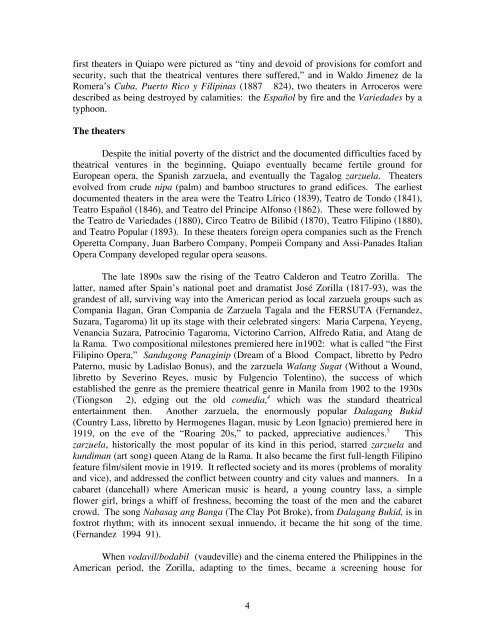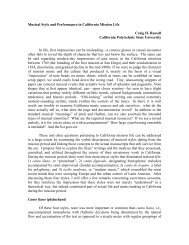Music in The Heart of Manila - Center for Iberian and Latin American ...
Music in The Heart of Manila - Center for Iberian and Latin American ...
Music in The Heart of Manila - Center for Iberian and Latin American ...
You also want an ePaper? Increase the reach of your titles
YUMPU automatically turns print PDFs into web optimized ePapers that Google loves.
first theaters <strong>in</strong> Quiapo were pictured as “t<strong>in</strong>y <strong>and</strong> devoid <strong>of</strong> provisions <strong>for</strong> com<strong>for</strong>t <strong>and</strong><br />
security, such that the theatrical ventures there suffered,” <strong>and</strong> <strong>in</strong> Waldo Jimenez de la<br />
Romera’s Cuba, Puerto Rico y Filip<strong>in</strong>as (1887 824), two theaters <strong>in</strong> Arroceros were<br />
described as be<strong>in</strong>g destroyed by calamities: the Español by fire <strong>and</strong> the Variedades by a<br />
typhoon.<br />
<strong>The</strong> theaters<br />
Despite the <strong>in</strong>itial poverty <strong>of</strong> the district <strong>and</strong> the documented difficulties faced by<br />
theatrical ventures <strong>in</strong> the beg<strong>in</strong>n<strong>in</strong>g, Quiapo eventually became fertile ground <strong>for</strong><br />
European opera, the Spanish zarzuela, <strong>and</strong> eventually the Tagalog zarzuela. <strong>The</strong>aters<br />
evolved from crude nipa (palm) <strong>and</strong> bamboo structures to gr<strong>and</strong> edifices. <strong>The</strong> earliest<br />
documented theaters <strong>in</strong> the area were the Teatro Lírico (1839), Teatro de Tondo (1841),<br />
Teatro Español (1846), <strong>and</strong> Teatro del Pr<strong>in</strong>cipe Alfonso (1862). <strong>The</strong>se were followed by<br />
the Teatro de Variedades (1880), Circo Teatro de Bilibid (1870), Teatro Filip<strong>in</strong>o (1880),<br />
<strong>and</strong> Teatro Popular (1893). In these theaters <strong>for</strong>eign opera companies such as the French<br />
Operetta Company, Juan Barbero Company, Pompeii Company <strong>and</strong> Assi-Panades Italian<br />
Opera Company developed regular opera seasons.<br />
<strong>The</strong> late 1890s saw the ris<strong>in</strong>g <strong>of</strong> the Teatro Calderon <strong>and</strong> Teatro Zorilla. <strong>The</strong><br />
latter, named after Spa<strong>in</strong>’s national poet <strong>and</strong> dramatist José Zorilla (1817-93), was the<br />
gr<strong>and</strong>est <strong>of</strong> all, surviv<strong>in</strong>g way <strong>in</strong>to the <strong>American</strong> period as local zarzuela groups such as<br />
Compania Ilagan, Gran Compania de Zarzuela Tagala <strong>and</strong> the FERSUTA (Fern<strong>and</strong>ez,<br />
Suzara, Tagaroma) lit up its stage with their celebrated s<strong>in</strong>gers: Maria Carpena, Yeyeng,<br />
Venancia Suzara, Patroc<strong>in</strong>io Tagaroma, Victor<strong>in</strong>o Carrion, Alfredo Ratia, <strong>and</strong> Atang de<br />
la Rama. Two compositional milestones premiered here <strong>in</strong>1902: what is called “the First<br />
Filip<strong>in</strong>o Opera,” S<strong>and</strong>ugong Panag<strong>in</strong>ip (Dream <strong>of</strong> a Blood Compact, libretto by Pedro<br />
Paterno, music by Ladislao Bonus), <strong>and</strong> the zarzuela Walang Sugat (Without a Wound,<br />
libretto by Sever<strong>in</strong>o Reyes, music by Fulgencio Tolent<strong>in</strong>o), the success <strong>of</strong> which<br />
established the genre as the premiere theatrical genre <strong>in</strong> <strong>Manila</strong> from 1902 to the 1930s<br />
(Tiongson 2), edg<strong>in</strong>g out the old comedia, 4 which was the st<strong>and</strong>ard theatrical<br />
enterta<strong>in</strong>ment then. Another zarzuela, the enormously popular Dalagang Bukid<br />
(Country Lass, libretto by Hermogenes Ilagan, music by Leon Ignacio) premiered here <strong>in</strong><br />
1919, on the eve <strong>of</strong> the “Roar<strong>in</strong>g 20s,” to packed, appreciative audiences. 5 This<br />
zarzuela, historically the most popular <strong>of</strong> its k<strong>in</strong>d <strong>in</strong> this period, starred zarzuela <strong>and</strong><br />
kundiman (art song) queen Atang de la Rama. It also became the first full-length Filip<strong>in</strong>o<br />
feature film/silent movie <strong>in</strong> 1919. It reflected society <strong>and</strong> its mores (problems <strong>of</strong> morality<br />
<strong>and</strong> vice), <strong>and</strong> addressed the conflict between country <strong>and</strong> city values <strong>and</strong> manners. In a<br />
cabaret (dancehall) where <strong>American</strong> music is heard, a young country lass, a simple<br />
flower girl, br<strong>in</strong>gs a whiff <strong>of</strong> freshness, becom<strong>in</strong>g the toast <strong>of</strong> the men <strong>and</strong> the cabaret<br />
crowd. <strong>The</strong> song Nabasag ang Banga (<strong>The</strong> Clay Pot Broke), from Dalagang Bukid, is <strong>in</strong><br />
foxtrot rhythm; with its <strong>in</strong>nocent sexual <strong>in</strong>nuendo, it became the hit song <strong>of</strong> the time.<br />
(Fern<strong>and</strong>ez 1994 91).<br />
When vodavil/bodabil (vaudeville) <strong>and</strong> the c<strong>in</strong>ema entered the Philipp<strong>in</strong>es <strong>in</strong> the<br />
<strong>American</strong> period, the Zorilla, adapt<strong>in</strong>g to the times, became a screen<strong>in</strong>g house <strong>for</strong><br />
4




